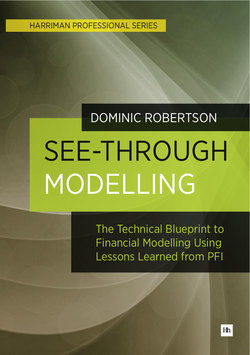Читать книгу See-Through Modelling - Dominic Robertson - Страница 4
На сайте Литреса книга снята с продажи.
ОглавлениеPreface
What this book covers
This book aims to provide the reader with a solid theoretical and practical basis for becoming an advanced modeller of see-through financial models in Microsoft Excel. Particular reference will be made to the project finance operating model, and the lessons learned from UK PFI will be drawn upon.
Topics covered by this book include:
financial theory
modelling theory
Excel theory and techniques
a step-by-step practical guide to building a project finance operating model
computer setup and efficient use
keyboard skills
macro-economic data collection and distribution.
Who this book is for
This book is for finance directors who are looking for a deeper understanding of the dynamics of their enterprise. Above all, this book is for finance directors who want to understand the benefits of adopting a see-through modelling strategy within their enterprise. These benefits are:
greater strategic vision due to great flexibility of forecast
lower risk of modelling errors due to standardised modelling
decreased reliance on individual analysts due to increased ease of model interchange
clear, detailed and holistic modelling function overview.
This book is also for aspiring financial modellers in general, and UK PFI project finance modellers in particular. Let me explain.
UK PFI has conceived over 900 projects in the UK and has gone a long way towards helping with the evolution of the financial model in Excel. Although there are some fundamental differences between a financial model for a public or private corporation and a model for a project finance operating company, there are also very many similarities.
I initially took knowledge learned from outside of project finance and used it for UK PFI modelling. Subsequently, I have successfully adapted knowledge from my UK PFI models for use in business areas as diverse as regulated energy distribution, media finance funding, telecom spectrum auctions, large container ports, high speed rail, and assorted manufacturing.
Readers of this book should keep in mind that learning to build a UK PFI project finance model is an extremely good place to start to learn financial modelling. UK PFI is like the world in miniature with simplified operations and simplified finance but containing all the accounting and cash elements that are necessary for wider application.
How this book is structured
The book is divided into three main sections preceded by an introduction and followed by an appendix of useful information.
The introduction outlines:
the modelling problem
the possible solutions available.
Part 1 covers the base theory for the professional modeller:
modelling theory, from mind-set to structure and on to content
finance theory, from reporting cycles to shareholder returns and banking cover ratios
FAST theory for Excel coding, from principles to rules and building blocks
Excel theory, from setup, through useful formulae, to automation and known issues
computer theory, for ways to optimise the use of the computer.
Part 2 is a practical guide to building a model. It includes:
building a model in 59 steps
modelling techniques in practice
ways of maintaining the modelling investment.
Part 3 is dedicated to further lessons that can be taken from PFI and applied to other industries.
The appendices include:
links and references
dictionary of terminology, including abbreviations
keyboard shortcuts
Excel functions
business maps
the tree analogy.
How to use this book
This guide should be used as a reference. Depending on your role and experience with modelling I would suggest that an efficient approach would be to:
1 Read this preface and the introduction to understand the objectives of the book
2 Skim read Part 2 before doing the same with Part 1, just to familiarise yourself with the overall content
3 Then follow the practical steps of Part 2 while using the theory in Part 1 as a reference guide.
If you are coming to all this without much experience then do not expect to rush through the book in a week. Rather, consider it your companion over time as you learn new ways of looking at and solving the modelling problem.
If you are new to modelling you may want to first concentrate on Part 1 to explore some immediately understandable theoretical concepts. If you are an experienced modeller then you can use this book as a reference.
If you are a finance director then you may want to ensure that someone within the enterprise is tasked with implementing the methods and knowledge contained within this book.
